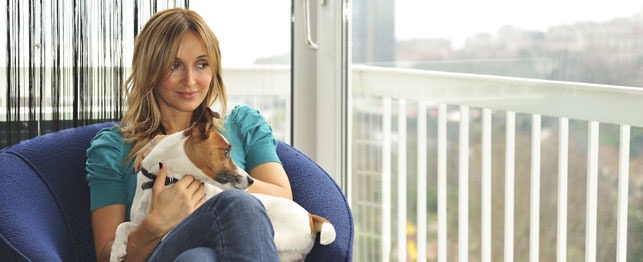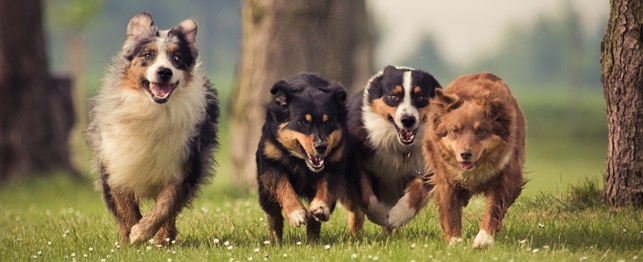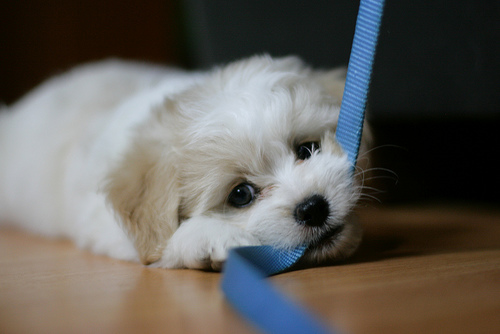Aggressive or Territorial dog behavior never seems like a problem to dog owners at first.
It becomes a growing concern over time.
It may start with your puppy shying away and then growling when you come too close to its crate. Perhaps your dog snarls or snaps when you get too close to its food dish or favorite toy. Whatever the symptoms are...
This pattern of behavior needs to be nipped in the bud!
This article will show you common dog training pitfalls that lead to aggressive dog behavior, how you can begin to correct the problem and what steps you can take to ensure it doesnt return.
You must enforce the rules from the moment you get your puppy to let him know what is and is not acceptable. His "hissy fits" are no exception to this practice.
If you don't correct the minor territorial behavior problem,
things will escalate until your dog becomes unpredictable and dangerous.
Take action from the first day to ensure this doesn't happen.
First off, one of the WORST things you can do when your dog becomes territorial is soothe him with petting or gentle speech. Your dog will interpret this as "Good Boy" and think of his barking, growling or snapping as appropriate behavior.
Instead, apply a very stern and sharp "NO" when your dog acts this way.
NEVER hit your dog. The "NO" command followed by a disapproving tone is enough to give your dog the message.
Do not avoid the situations of getting too close to his food or putting your hands inside the crate. In fact, you should continuously perform these actions to push the limits of your dog's boundaries.
You NEED to pronounce your status as the Alpha Dog of the house. He needs to respect and follow YOUR lead not the other way around.
Ultimately your dog will understand the situation. Harp on testing your dogs reactions and always correct with the "NO" command. You may say "Good Boy" and pet your dog only if he is perfectly behaved while you are in the crate, touching his food or performing any other trigger action that normally creates a negative response.
Part of territorial behavior can stem from a dog not being properly socialized from the beginning. Don't hide your puppy.
From day 1, take him around and bring it around children and other adults.
Get your dog familiar with the world right away so it doesn't fear its surroundings.
One of the biggest criticisms to taming a dog's aggressive behavior comes from homeowners that originally bought the dog for a sense of protection.
They may say:
"If I make this dog TOO friendly, he won't bark or attack if an intruder ever tries to break into the house"
This school of thought is simply untrue.
Dogs are far more instinctual than we give them credit for. Trust me, if a masked man breaks into the home in the middle of the night, your dog will know something is wrong and take a defensive stance.
Bottom line: between the two extremes in behavior, you will be much happier having an obedient dog with a docile or playful temperament.
Never encourage aggression with treats or the "Good Boy" command. I can't say this enough.
If a few weeks go by and you see no change in behavior with your dog's aggression, it's time to bring in the professionals. Call a local dog trainer who can tame your dog's wild side efficiently and safely.
Remember,
you CAN tame your dog's aggression so long as you are not accidentally encouraging it. Be on the lookout from the moment the dog enters your home and guide his personality to become a trusted, loving member of the family.

 City Slickers: 5 Tips for Urban Living with Cats & Dogs
City Slickers: 5 Tips for Urban Living with C
City Slickers: 5 Tips for Urban Living with Cats & Dogs
City Slickers: 5 Tips for Urban Living with C
 Doggie Day Care
Doggie Day Care
Doggie Day Care
Doggie Day Care
 Parks & Recreation: 7 Tips for Enjoying Dog Parks
Parks & Recreation: 7 Tips for Enjoying Dog P
Parks & Recreation: 7 Tips for Enjoying Dog Parks
Parks & Recreation: 7 Tips for Enjoying Dog P
 How to Balance Your Pets Play and Relaxation
How to Balance Your Pets Play and Relaxation
How to Balance Your Pets Play and Relaxation
How to Balance Your Pets Play and Relaxation
 Teaching Your Dog Polite Leash Skills - Canine Manners 101 Dog Training Series
Teaching Your Dog Polite Leash Skills
This article i
Teaching Your Dog Polite Leash Skills - Canine Manners 101 Dog Training Series
Teaching Your Dog Polite Leash Skills
This article i